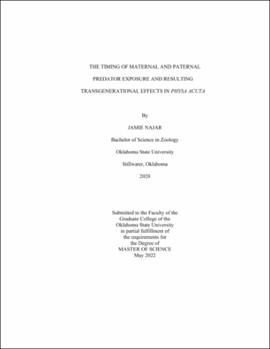| dc.contributor.advisor | Luttbeg, Barney | |
| dc.contributor.author | Najar, Jamie | |
| dc.date.accessioned | 2023-04-03T20:51:31Z | |
| dc.date.available | 2023-04-03T20:51:31Z | |
| dc.date.issued | 2022-05 | |
| dc.identifier.uri | https://hdl.handle.net/11244/337218 | |
| dc.description.abstract | The interactions that an individual has with its environment can impact the physical traits and behaviors of both that individual and its offspring. This phenotypic plasticity can influence the evolution of a population, or the relationships between species. Such is the case when organisms use cues from their environment to develop more effective defenses against predation. Currently, we do not have a consistent record of what factors are most influential in these effects or understand the mechanisms behind them, especially in hermaphroditic species. In this study, I investigated how the morphology and behavior of a hermaphroditic pond snail, Physa acuta, is affected by parental exposure to a predator cue, and how those effects differed based on the exposure of mothers versus fathers and the timing of those exposures. Two generations of snails were bred and raised in the laboratory. The parental F1 generation was exposed to one of three treatments: control cue, early exposure to a predator cue, or late exposure to a predator cue. The F2 generation was raised without exposure to a predator cue, then underwent two anti-predator behavior experiments once sexually mature. The behavioral trials assessed a snail’s predator avoidance behavior when exposed to a predator cue, and the latency trials quantified if there was a difference in how quickly a snail exhibited this behavior, if at all, when exposed to a predator cue versus a control cue. I obtained soft body mass, shell mass, and shell morphometric data on both the F1 and F2 generations at sexual maturity. I found that the exposure of a parent to a predator cue affected some aspects of the phenotypes of their offspring. The timing of exposure had some effect on overall shell shape, but I found no apparent evidence for differences between maternal and paternal effects. My results indicate that exposure to a predator cue is the main factor contributing to both within-generation and transgenerational effects. Maternity or paternity and timing have less influential roles in plasticity, but effects may be revealed under more specific conditions such as when environmental information passed down from the parents is corroborated by the experiences of offspring. | |
| dc.format | application/pdf | |
| dc.language | en_US | |
| dc.rights | Copyright is held by the author who has granted the Oklahoma State University Library the non-exclusive right to share this material in its institutional repository. Contact Digital Library Services at lib-dls@okstate.edu or 405-744-9161 for the permission policy on the use, reproduction or distribution of this material. | |
| dc.title | Timing of maternal and paternal predator exposure and resulting transgenerational effects in Physa acuta | |
| dc.contributor.committeeMember | Grindstaff, Jen | |
| dc.contributor.committeeMember | Reichert, Michael | |
| osu.filename | Najar_okstate_0664M_17643.pdf | |
| osu.accesstype | Open Access | |
| dc.type.genre | Thesis | |
| dc.type.material | Text | |
| dc.subject.keywords | critical windows | |
| dc.subject.keywords | maternal and paternal effects | |
| dc.subject.keywords | Physa acuta | |
| dc.subject.keywords | predator-prey interactions | |
| dc.subject.keywords | transgenerational plasticity | |
| thesis.degree.discipline | Integrative Biology | |
| thesis.degree.grantor | Oklahoma State University | |
